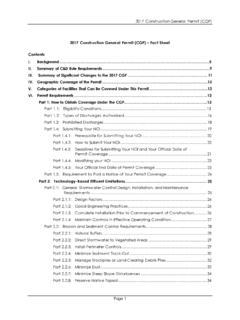Transcription of MS4 Permits: Fact sheet: Final MS4 general permit remand rule
1 fact sheet Final Municipal Separate Storm Sewer System (MS4) general permit remand Rule November 17, 2016 EPA Note: This fact sheet describes the Final Municipal Separate Storm Sewer System (MS4) general permit remand Rule, signed by the Administrator, on November 17, 2016. The pre-publication version of the Federal Register Notice is available at: #proposed. EPA made every attempt to ensure the accuracy of this document; however, in the event of a conflict between this document and the official version of the regulation published in the Federal Register, the Federal Register version controls. Page 2 of 7 Final MS4 general permit remand Rule fact sheet Overview The Environmental Protection Agency (EPA) is changing its regulations governing how small municipal separate storm sewer systems (MS4s) obtain coverage under National Pollutant Discharge Elimination System (NPDES) general permits.
2 This change will promote greater public engagement through clear requirements on the opportunities for public participation in the permitting process. The Final MS4 general permit remand Rule establishes two alternative approaches an NPDES permitting authority can use to issue and administer small MS4 general permits that address a partial remand of the Phase II stormwater regulations by the Court of Appeals for the Ninth Circuit. Both approaches ensure that the permitting authority establishes what is necessary for the MS4 to reduce the discharge of pollutants from the MS4 to the maximum extent practicable, to protect water quality, and to satisfy the appropriate water quality requirements of the Clean Water Act, referred to as the MS4 permit standard, and that the public participation requirements of the Clean Water Act (CWA) are met.
3 Why Was This Rule Necessary? The Phase II stormwater rule was challenged in petitions for review filed by environmental groups, municipal organizations, and industry groups, resulting in a partial remand of the rule. Environmental Defense Center v. Environmental Protection Agency, 344 832 (9th Cir. 2003) (EDC). The court remanded the phase ii rule s provisions for small MS4 general permits because they lacked procedures for permitting authority review and public notice and the opportunity to request a hearing on Notices of Intent (NOIs) for authorization to discharge under a general permit . In reviewing how the phase ii rule provided for general permit coverage for small MS4s, the court found that the way in which NOIs function under the rule was not the same as in other NPDES general permits.
4 Other general permits contain within the body of the general permit the specific effluent limitations and conditions applicable to the class of dischargers for which the permit is available. For those general permits, authorization to discharge under a general permit is obtained by filing an NOI in which the discharger agrees to comply with the terms of the general permit and in which the operator provides some basic information ( , site location, receiving waters) to help determine eligibility. In contrast, the court held that under the phase ii rule , because the NOI submitted by the MS4 contains the information describing what the MS4 will do to reduce pollutants to the maximum extent practicable (MEP), the NOI is the functional equivalent of an individual permit application.
5 See EDC, 344 at 857. Because the CWA requires public notice and the opportunity to request a public hearing for all permit applications, the court held that failure to require public notice and the opportunity for a public hearing for NOIs under the phase ii rule is contrary to the Act. See EDC, 344 at 858. Similarly, the court found that the phase ii rule allows the MS4 to identify the BMPs that it will undertake in its stormwater management program without any permitting authority review. The court held that the lack of review to ensure that the measures that any given operator of a small MS4 has decided to undertake will in fact reduce discharges of pollutants to the maximum extent practicable also does not comport with CWA requirements.
6 The court stated, That the Rule allows a permitting authority to review an NOI is not enough; every permit must comply with the standards articulated by the Clean Water Act, and unless every NOI issued under general permit is reviewed, there is no way to ensure that such compliance has been achieved. See EDC, 344 at 855 The court therefore Page 3 of 7 vacated and remanded those portions of the phase ii rule that address these procedural issues .. so that EPA may take appropriate action to comply with Clean Water Act. See EDC, 344 at 858. What Was Included in the Proposed Rule? EPA proposed for comment three options to address the regulatory shortcomings found in the remand decision. 1. Option 1 ( Traditional general permit Approach ) Under the proposed Traditional general permit Approach, the permitting authority would establish in any small MS4 general permit the full set of requirements that are deemed necessary to meet the MS4 permit standard ( reduce pollutants to the maximum extent practicable, protect water quality and satisfy the appropriate water quality requirements of the Clean Water Act ), and the administrative record would include an explanation of the rationale for its determination.
7 (This approach contrasts with the original regulations, which appeared to the court to provide the permittee with the ability to establish its own requirements.) Once the permit is issued, and the terms and conditions in the permit are fixed for the term of the permit , neither the storm water management program (SWMP) document nor the submittal of an NOI would represent new permit requirements. Thus, because the permit would contain all of the requirements that would be used to assess permittee compliance, the permitting authority would no longer need to rely on the MS4 s NOI as the mechanism for ascertaining what will occur during the permit term. Under this approach, the function of the NOI would be more similar to that of any other general permit NOI, whereby the NOI is used to establish certain minimum facts about the discharger, including the operator s contact details, the discharge location(s), and confirmation that the operator is eligible for permit coverage and has agreed to comply with the terms of the permit .
8 By removing the possibility that effluent limits could be proposed in the NOI (and for that matter in the SWMP) and made part of the permit once permit coverage is provided, the NOI would no longer look and function like an individual permit application, as the court found with respect to MS4 NOIs under the Phase II regulations currently in effect. Therefore, it would not be necessary to carry out the type of additional permitting authority review and public participation procedures contemplated by the Ninth Circuit court in the remand decision. These requirements would be met during the process of issuing the general permit . 2. Option 2 ( Procedural Approach ) Under the proposed Procedural Approach, the permitting authority would establish applicable permit requirements to meet the MS4 permit standard by going through a second permitting step following the issuance of the general permit (referred to as the base general permit ), similar to the procedures used to issue individual NPDES permits.
9 Eligible MS4 operators would be required to submit NOIs with the same information that has always been required under the Phase II regulations, that is, a description of the BMPs to be implemented by the MS4 operator during the permit term, and the measurable goals associated with each BMP. Following the receipt of the NOI, the permitting authority would review the NOI to assess whether the proposed BMPs and measurable goals meet the MS4 permit standard. If not, the permitting authority would request supplemental information or revisions as necessary to ensure that the submission satisfies the regulatory requirements. Once satisfied with the submission, the permitting authority would be required to propose incorporating the BMPs and measurable goals in the NOI as permit requirements and to provide public notice of the NOI and an opportunity to submit comments and to request a hearing in accordance with through After consideration of comments received and a hearing, if held, the permitting authority would provide notice of its decision to authorize coverage under the general permit , along with any MS4-specific requirements established during this second process.
10 Upon completion of this process, the MS4 Page 4 of 7 would be required to comply with the requirements set forth in the base general permit and the additional terms and conditions established through the second-step process. 3. Option 3 ( State Choice Approach ) The proposed rule also requested comment on a State Choice Approach, which would allow permitting authorities to choose either the Traditional general permit Approach or the Procedural Approach, or some combination of the two as would best suit their needs and circumstances. As described in the proposed rule, the permitting authority could, for example, choose to use Option 1 for small MS4s that have fully established programs and uniform core requirements, and Option 2 for MS4s that it finds would benefit from the additional flexibility to address unique circumstances, such as those encountered by non-traditional MS4s ( , state departments of transportation, public universities, military bases).











